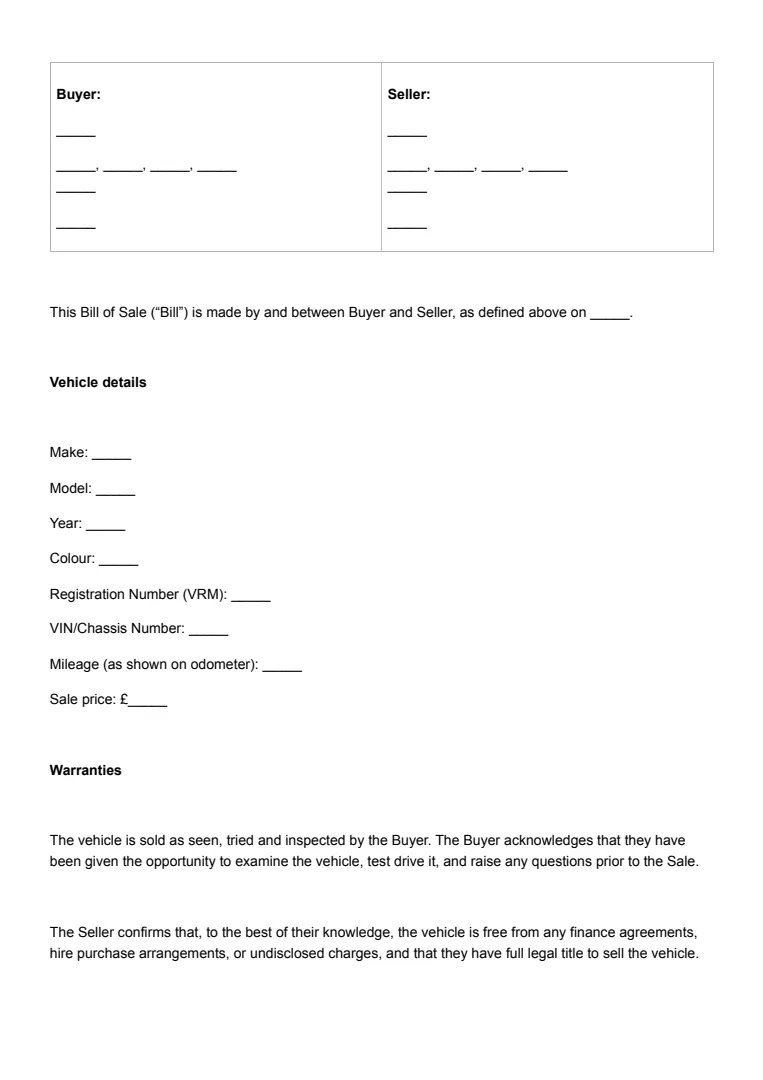What Is a Bill of Sale?
A bill of sale is a legal document that confirms a transaction where an item or asset is sold from one person to another. Think of it as a receipt that not only records the exchange but also proves you've become the new owner of an item.
Normally prepared by the seller, this document includes details like the buyer's and seller's names, a description of the item, its price, and the date of sale. This helps prevent disputes about the transaction later on.
Common uses of a bill of sale include:
- Vehicles: When you buy a car, caravan, or boat, a bill of sale secures your ownership.
- Personal items: It could be for smaller personal items like electronics or furniture.
- Livestock: Even for animals, this document can record a sale.
For the document to be legally binding, make sure it accurately reflects the terms agreed upon by both parties. Additionally, both the buyer and seller should sign it.
A good bill of sale offers validity by including all necessary details. If a disagreement occurs, the bill of sale stands as evidence of what was agreed upon.
This simple yet essential piece of paperwork safeguards both the buyer and the seller. Make sure to keep it safe, as it might come in handy down the line.
When Is a Bill of Sale Needed?
When you're buying or selling items like vehicles, such as cars or motorcycles, a bill of sale can be important to verify the transfer of ownership. You'll need it to register the vehicle and update the title with the authorities.
It's especially important in a trade where you might exchange goods. This way, everyone knows exactly what they agreed to exchange.
Gifts, too, might warrant a bill of sale. Although not an outright sale, having documentation can prevent disputes about ownership later on.
You’ll often come across bills of sale in real estate and other personal goods transactions as well. Having a written record keeps everyone on the same page and provides legal proof of the transaction.
How to Write a Bill of Sale
You can create a clear and comprehensive bill of sale by following these steps.
Step 1: Gather Buyer and Seller Information
Start by collecting the necessary details for both the buyer and seller, including full names and addresses.
This step ensures both parties are clearly identified in the document, which is essential for legality and clarity.
Step 2: Describe the Property or Item
Provide a detailed description of the property or item being sold.
For items like vehicles, include specifics such as the year, make, model, and odometer disclosure statement.
This level of detail helps avoid disputes about the item’s condition and identity.
Step 3: State the Purchase Price and Payment Method
Clearly note the purchase price and the agreed method of payment (e.g., cash, cheque, or another form).
To avoid any misinterpretation, state the total sales price in both numbers and words.
Step 4: Specify the Date of Sale
Mention the date of sale, as this marks the official transfer of ownership.
Ensuring the document is dated and up-to-date is crucial for legal and personal records. Make sure the date is clear and precise.
Step 5: Finalise With Signatures
Both the buyer and seller must provide their signatures to finalise the document. This signature acts as a mutual agreement to all terms laid out.
Ensuring both parties sign the document makes the bill of sale legally enforceable and provides assurance for both sides.
You can use a bill of sale template for the UK as a guide. This includes vehicle bill of sale templates, private sale receipt templates and boat bill of sale templates for the UK.












